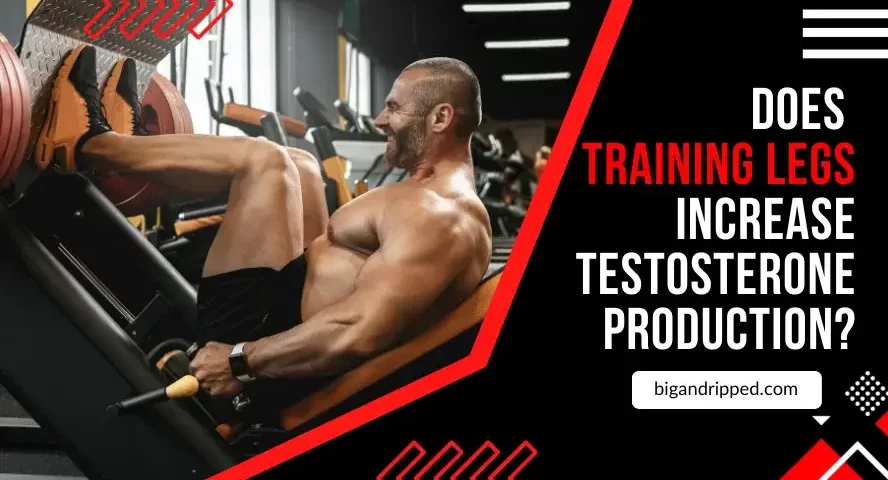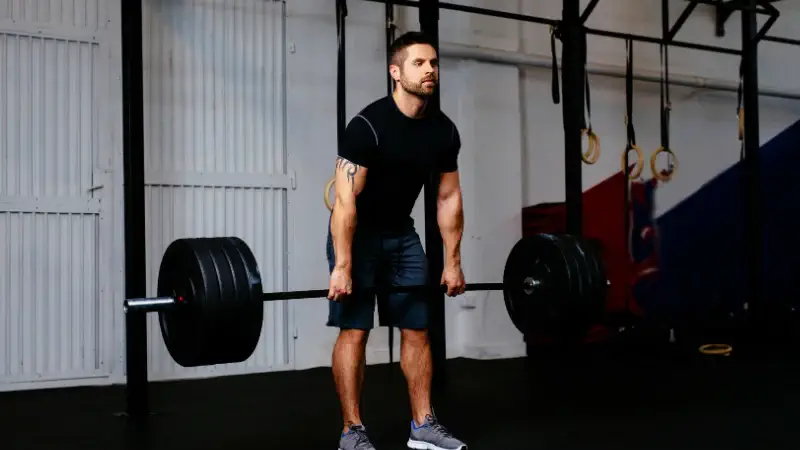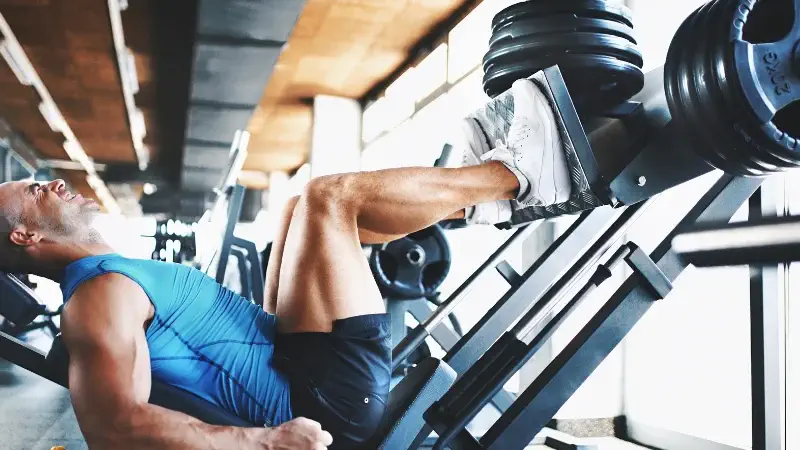- Have any questions?
- hello@bigandripped.com
How Does Training Legs Increase Testosterone Production?

Don’t skip leg day, or your testosterone levels will pay the price!
Yeah, Bud! Leg training engages large muscle groups and prompts the body to release more testosterone and growth hormone.
There are several studies that have shown that building muscle helps in boosting testosterone levels in the body. Compound exercises such as squats, deadlifts, and lunges put a significant demand on your body.
These movements require a lot of effort from multiple large muscle groups simultaneously. In response, your body releases hormones like testosterone and growth hormone to aid in muscle repair and growth.
Research suggests that intense workouts, like heavy leg training, create a stress response in the body.
When you recover adequately, your body adapts by releasing more testosterone, facilitating muscle repair and growth during the recovery phase.
Let’s find out whether “Does training legs increase testosterone”.
Key Insights
Table of Contents
- Leg exercise does increase testosterone levels in men naturally by supporting overall well-being.
- Performing heavy sets with lifting heavy weights enhances the body’s hormonal response, including testosterone and growth hormone.
- Following up on some tips to enhance testosterone production will also indeed to know better outcomes.
- Adding up other testosterone-boosting exercises with leg exercises to increase testosterone can significantly boost the hormone levels.
Does Training Legs Increase Testosterone?
Yes, it does.
Training legs can indeed have a significant impact on testosterone levels within the body.
Undoubtedly, we all know adding weights on leg training days requires too much effort and eventually is the toughest workout form.
This is because several trainers and experts claim that it uses a larger group of muscles and asks your body to push more effort throughout the training.
A study is performed on the hormonal reaction of strength training in both genders after completing two distinct lower-body resistance training regimens. Resultantly, during a strenuous exercise session, growth hormone (GH), testosterone, and bioavailable testosterone increased in both groups.
This eventually gives the potent answer to “Does training legs increase testosterone in males” is Yes.
Performing the set of complex exercises significantly improves testosterone levels.
These exercise regimens can effectively raise your hormone responses when paired with a healthy diet and recuperation plan.
Leg Training and Testosterone
Firstly, understanding the hormonal response to resistance training illuminates how leg exercises influence testosterone levels.
Compound exercises that target large muscle groups, including those in the legs, create a substantial demand on the body.
This demand signals the endocrine system to release hormones like testosterone and growth hormone to support muscle repair, growth, and adaptation.
Therefore, leg training, being among the most demanding workouts, prompts a significant hormonal release, contributing to higher testosterone levels.
The mentioned studies show a clear relation between leg exercises and testosterone levels.
Significantly, the metabolic impact of leg training plays a role in influencing hormonal balance.
Studies have shown that working out larger muscle groups including quadriceps, hamstrings, and glutes, requires significant energy expenditure during both the exercise and recovery phases.
This eventually forces the body to push efforts beyond the limit and ask for additional energy expenditure.
To respond to this needed metabolic demand from the body ultimately helps the body release more anabolic hormones like testosterone, fostering muscle repair and growth.
Leg Exercises That Boost Testosterone
Studies have mentioned the intensity you put into exercises clearly shows the impactful results.
Here are some of the leg exercises that does increase testosterone levels in men.
#1. Squats

One of the best exercises is squatting to increase testosterone levels.
They not only assist in the development of muscle mass but also increase the production of testosterone and tighten the lower body muscles.
Studies have shared that lifting heavy weights with lower reps helps stimulate testosterone release more effectively compared to lighter weights and higher reps.
If you want to increase your testosterone levels naturally, squats are an excellent exercise. As your strength increases, start with a lower weight and gradually increase it.
Engaging in frequent heavy squats will enhance your strength and testosterone levels while also helping to advance your general athletic performance.
#2. Deadlifts

Deadlifts are a full-body workout that is known to be an effective way to boost your stamina and intentionally boost testosterone. The muscle group on which deadlifts work includes, core and lower back muscles, as well as your glutes and hamstrings.
The heavy lifting involved in deadlifts stimulates the central nervous system and encourages the body to release more testosterone.
However, the impact on testosterone levels can vary among individuals, additionally taking care of other factors also plays a significant role.
As per a journal, intense powerlifting training increases the response of testosterone in the body. Overall, incorporating deadlifts into a well-rounded workout routine can contribute to overall muscle development and potentially aid in optimizing testosterone levels.
#3. Leg Press

Looking for the optimum benefits of training legs 3 times a week?
Just add leg presses. It’s one of the most effective exercises to train your quads. The workout also needed a bunch of stamina and strength.
For that, it asks your body to generate hormones like testosterone and growth hormone to support the exercises.
When performed with heavy weights and adequate intensity, the leg press can be an effective exercise for promoting muscle growth and potentially enhancing testosterone production.
Always prioritize proper form and technique while performing leg press exercises as it is said to be one of the trickiest workout forms and can cause injury.
Keep checking on the weights and the lifts, never push too much as it may lead to several other complications.
#4. Lunges

Weighted lunges can also significantly increase testosterone, this is because the amount of pressure the body needs to push requires additional effort.
In order to fulfill the efforts the body gathers all the free testosterone at the time of performing the workout. Having the instant surge of the hormone eventually forces the body to produce more testosterone.
Performing lunges with added weight or resistance increases the intensity of the exercise, and studies have supported that HIIT exercises influence testosterone production.
Lunges are not just a leg exercise; they require stability and engagement from the core muscles as well.
This full-body engagement can enhance the overall hormonal response compared to isolated exercises.
While discussing the fact we tried to cover the answer of why does training legs increase testosterone and the reason why you should indulge in it.
Further, for now, we’re stepping into the essential tips individuals need to know to incorporate leg training to optimize testosterone levels.
Tips for Optimizing Testosterone Through Leg Training
Another aspect to consider is the stress-recovery cycle induced by intense leg workouts.
Exercise, particularly strenuous resistance training, imposes stress on the body.
This stress triggers the release of cortisol, a stress hormone, and in response, the body increases testosterone production during the recovery phase.
Adequate rest and recovery following leg workouts are essential for the body to adapt and grow stronger, leading to increased testosterone levels over time.
Here are some of the exercises that significantly enhance the testosterone levels in men.
Furthermore, keeping a check on the weights is also important. As putting too much pressure can somehow push your body to force more, this inevitably causes serious situations.
You may experience an instant drop in testosterone levels and get fatigued between sets. Also, give your muscles time to recover.
Overtraining can negatively impact testosterone levels. Ensure you’re getting enough sleep and managing stress, undoubtedly both are crucial for hormonal balance.
Besides these, there are some other exercises that also help boost testosterone levels in men and women as well.
Other Exercises to Boost Testosterone
The saying “You shouldn’t skip a leg day” is common. Leg exercises are crucial for a number of reasons.
But there are some of the other exercises that help boost testosterone levels in men.
1: Compound Movements
Compound movements comprise some effective exercises that require an additional push from the body which eventually supports testosterone levels.
2: Sprinting or High-Intensity Interval Training (HIIT)
This is yet another workout form that needs an instant surge of testosterone levels too.
3: Calisthenics and Bodyweight Exercises
Well, these body workouts seem easy and not effective, but actually, they also need more push and effort. This eventually helps the body to boost testosterone levels naturally.
4: Circuit Training
Circuit training is a training type that needs an equal interval of rest time and then pushing harder. This gives your body enough time to rest and collectively push more to produce hormones like testosterone.
5: Aerobic Exercise
Apart from cardiovascular exercises, combining aerobics also stimulates the natural flow of hormones.
Therefore, adding up these exercises along with leg exercise benefits for male and help them get boosted testosterone levels naturally.
Now, with this, it’s time to conclude the overall discussion with a final recap.
Conclusion
Significantly, we’ve found that leg exercise does increase testosterone levels in men. Well, the whole story is about pushing your body into a state where it becomes forced to produce more testosterone.
However, you can also perform strength training for testosterone, as this workout format also resembles similar benefits to some extent.
This is because it also requires too much to energy, stamina, and strength to lift weight easily.
Further, while lifting weight you become more active and somehow benefit overall hormonal balance in men.
Hope the shared information has given you a clear analysis of the benefits of training legs every day for men.
Do share this with your gym buddies and help them with the latest findings about leg training and testosterone.

